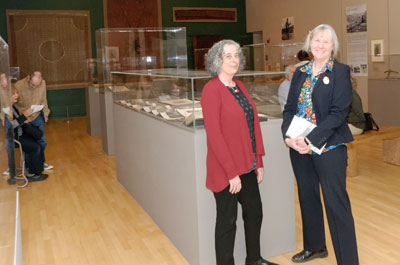
and along the right wall are biological specimens and artifacts from
the Koelz collections
CHICAGO: Carla Sinnapoli, curator and anthropologist at Asian Archaeology at University of Michigan, (UM), delivered a gallery talk “Collecting Kashmir: The Expeditions of Walter N. Koelz” (1895-1989) here at Mary and Leigh Block Museum of Art, April 8, touching upon his contributions to Indian art and architecture.
Koelz was a UM research fellow entrusted in the 1930s with acquiring distinctive biological specimens and human artifacts for its museums through expeditions in British India.
Many exotic items in the Blocok’s “Collecting Culture Himalaya Through the Lens”, companion exhibition and four in the main “Collecting Paradise: Buddhist Art of Kashmir and Its Legacies” are from the Koelz Collection. Sinopoli’s talk addressed the Block’s central concern of questioning the ethics behind collecting. “Koelz travel journal and Tucci’s published work demonstrates at times prejudiced opinions and unscrupulous collecting methods, which were questioned even in their day.
Seen through a contemporary lens, their attitudes and actions provide an opportunity to ask important questions about how and why art from one culture is collected by individuals from another culture,” reads the introductory panel to Collecting Culture.
“Koelz’s journals capture a callous attitude towards beliefs, customs, and the economic difficulties in the region, recording how he often manipulated situations to obtain objects for which he paid as little as possible,” says his introductory panel.
Introduced by Kathleen Berzock, Director of Curatorial Affairs, Sinopoli has published in 2013 a work on Koelz’s 1932-1934 UM 18-month expedition and also transcribed his scribbled journals. “The prolific diarist was an astute observer of local life and customs, recording information on ethnobotany, pastoral migrations, marriage patterns and local politics. He was an avid collector of a range of craft goods and artistic products, collecting pottery, wooden objects, sacred images, sculptures, and textiles. With no formal training in Asian art, he had an eye for quality, and amassed an impressive and valuable collection.” Some of the Tibetan objects he acquired have since gone out of use and are no longer recognized by lamas.
The Indian assistant who made this alien world accessible was the native scion of an impoverished princely family. “Capitalizing on Rup Chand’s language skills and cultural insights, they also acquired hundreds of objects, including the jewelry and textiles in this room, and Buddhist sculptures and paintings,” reads Chand’s introductory panel.
Koelz began ‘partnering’ with this ‘Thakur’ (aristocrat) already during his previous stay (1930-32) in Kulu at the Urusvati Research Institute run by Russian theosophist Nicholas Roerich and his wife-mystic Helena. Although a zoologist, the American adventurer was hired as a botanist to investigate the medicinal properties of Indian plants, often messing up the results. In the eventual bitter falling apart with the Roerichs, at least partly due to his intimacy with Chand, the latter decisively stuck with Koelz.
From titular head (Rinpoche) of the region’s Gelugpa monasteries, Koelz managed to extract a letter authorizing transfer of 15 scroll paintings (tanka) from Likir monastery. Going first to nearby Karsha monastery, he takes away a wrathful protective deity abandoned in a heap still considered sacred.
Received and housed sumptuously at Likir, he pressures its head lama into letting him select whatever he fancies for rupees 600 plus 100 as tip. Though the monk disciples refused him seven of these, he ended up taking 17, four of which are exhibited in “Collecting Kashmir.” UM was upset to receive only 52 of about 100 tankas collected.
Trailing just two weeks behind Guiseppe Tucci, he accuses his despised rival collector of hiking up costs by paying indiscriminately. But Tucci, the pioneering Orientalist who had close ideological and personal ties with the sponsoring Italian fascist government, does not even mention Koelz, as if he were the only European scouting the Himalayas.
Elizabeth Vasulingam






